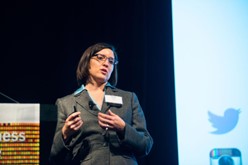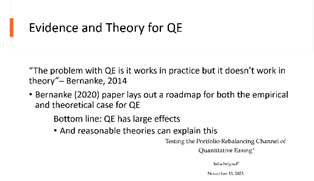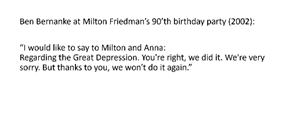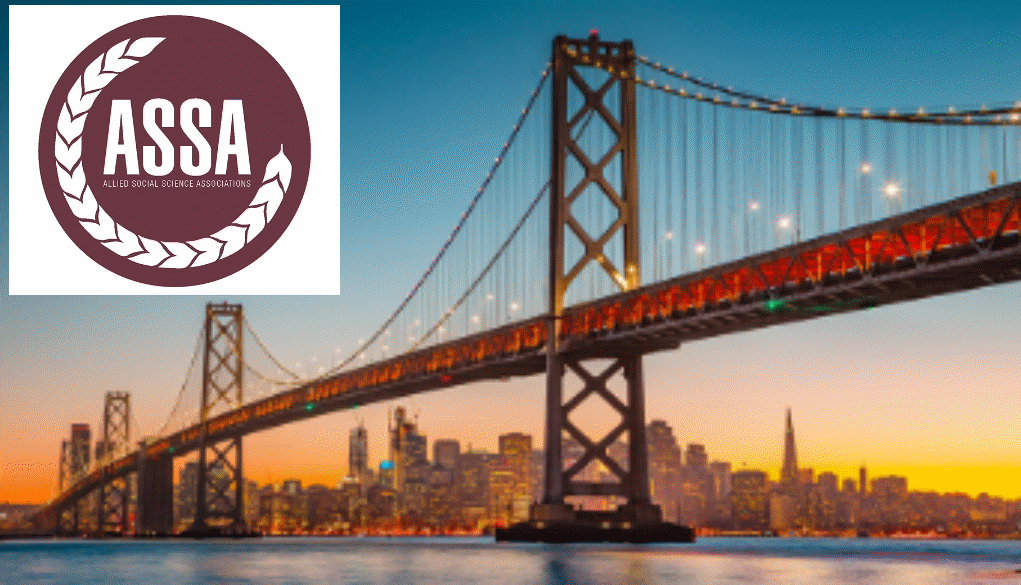By Michael Roberts
Every year, I report on the annual proceedings of ASSA, the Alliance of Social Science Associations, run by the American Economics Association. It is the biggest economics conference in the world, with over 13,000 economics students and professors attending and hundreds of papers presented in sessions over three days. And there are addresses by the ‘great and good’ of mainstream economics, attended by hundreds. But also, there are sessions organized by radical economics groups, attended by handfuls.
The question of AI dominated the conference
This year the conference in San Francisco was dominated by one theme: artificial intelligence (AI). Previous conferences have concentrated on climate change or economic growth or inflation. Not this year, and this is no surprise as AI is seen by mainstream economics as the likely great saviour of capitalism in the major economies. The hope is that poor economic growth in the major economies, particularly in the productivity of labour and productive investment, can be overcome by a boom in AI investment and the consequent huge and sustained productivity boost that AI will deliver, thus transforming economic expansion through the rest of this decade and beyond: an AI-driven revolution.
So there were many sessions on how AI would affect the future of work and on its impact on the wider economy. In one web recorded session, several top economists in the field outlined AI’s impact. Tom Mitchell of Carnegie Mellon University told the large audience that AI was a powerful and fast-developing technology, that was not perfect and not always accurate, but it was improving fast. AI was likely to automate routine tasks — like tracking inventory or stocking warehouses — and partially automate high-skill tasks, like writing legal documents. AI could help workers whose jobs require judgment, problem-solving and decision making — like teachers, health technicians, or customer service agents — do their jobs better. As AI gets better and is applied in more ways or leads to other innovations, it would make people more productive. The speed of that change, however, remains uncertain and there is no guarantee that any benefits will be shared equally. “AI raises big questions about fairness, privacy, safety, national security and civil discourse. How society handles these concerns will shape how much AI affects our lives and jobs.” Indeed.
John Horton (Massachusetts Institute of Technology) argued for AI-based economic forecasts. They “align closely with the accuracy and distribution of human predictions, and perform especially well at medium-and long-term horizons, often outperforming human forecasts.” So AI economic forecasting could be a low-cost alternative to human forecasting (not good news for economists).
The economic implications of AI
In another session on the economic implications of AI, Alena Wabitsch (University of Oxford) examined the link between labour market developments and AI in 16 European countries over the period 2011- 2019. She found that only very few countries show a decline in employment shares of occupations more exposed to AI-enabled automation. So positive news. In contrast, Pamela Mishkin from Open AI looked at Generative Pre-trained Transformer (GPT) models and found that approximately 80% of the US workforce could have at least 10% of their work tasks affected by the introduction of GPTs, while around 19% of workers may see at least 50% of their tasks impacted. Not so good. Longji Li (IMF) in another study found that the advanced economies faced higher exposure than the so-called emerging economies due to a higher employment share in professional and managerial occupations. Workers in the upper tail of the earnings distribution were more likely to be in occupations with high exposure, but also could potentially gain from AI.
Presentations by Susan Athey

Most interesting were the presentations by Susan Athey from Stanford University. She argued it was difficult to measure just what the causal effect of AI would be on productivity and work. “AI has enormous positive potential for society,” Athey said in her opening remarks, noting the value of AI-driven solutions related to education, training, remote work, government services, medicine, and other areas.
But while that might mean a wider array of general-purpose applications, from retail recommendations to medical-outcome predictions, it also meant more ‘black-box processes’ within the AI model that even the engineers building them might not fully understand. She worried that “Businesses may be indifferent between a worker and a machine from a cost perspective. And if they’re indifferent, they’ll go with the machine to protect their bottom line.” Indeed, we “can’t always count on companies to take the longer-term perspective.”
Athey outlined forks in the road for the impact of AI. The first fork was economic growth, particularly productivity growth. “Boosting productivity growth may be the globe’s most fundamental economic challenge.” But the impact of AI on this could be limited. Despite the rapidly improving technical capabilities of AI, its adoption by businesses may continue to be slow and confined to large firms. The economics of AI may turn out to be of a very narrow labour-saving variety. Displaced workers might disproportionately end up in even less productive and less dynamic jobs, further muting any aggregate benefit to the long-term productivity growth rate of the economy.
On the other hand, AI could end up complementing workers—freeing them to spend more time on nonroutine, creative, and inventive tasks rather than just replacing them. As a result, more workers can spend more time working on novel problems and a growing share of the labour force would increasingly come to resemble a society of research scientists and innovators. The result is an economy not simply at a higher level of productivity, but at a permanently higher growth rate.
AI and income inequality
The second fork was income inequality. In the first scenario, AI leads to higher income inequality. Technologists and managers design and implement AI to substitute directly for many kinds of human labour, driving down the wages of many workers. The number of jobs under threat from AI competition eventually grows much larger. Or alternatively, AI leads to lower income inequality because the main impact of AI on the workforce is to help the least experienced or least knowledgeable workers be better at their jobs. If employers shared these gains with workers, distribution of income would become more equal.
The third fork was industrial concentration, which has risen dramatically in many advanced economies. AI could make this worse as only the largest firms intensively use AI in their core business. Alternatively, if open-source AI models become widely available, this would give small businesses access to industry-leading production technologies they could never have had before.
No clear picture on how fast AI will impact different economies
Doubts about the speed of any impact on economies were high. Diane Coyle of Cambridge University reckoned that “we should temper our expectations about AI’s economic impact, at least in the foreseeable future. Although the AI industry itself is poised to grow rapidly, there is little reason to expect that it would significantly boost GDP growth in the short or medium term.” James Manyika from Google reckoned that “Right now, everyone from my old colleagues at McKinsey Global Institute to Goldman Sachs are putting out these extraordinary economic potential numbers — in the trillions — [but] it’s going to take a whole bunch of actions, innovations, investments, even enabling policy … The productivity gains are not guaranteed. They’re going to take a lot of work.” The use of generative AI to draft software code is not enough. “In the US, the tech sector is about 4 per cent of the labour force. Even if the entire tech sector adopted it 100 per cent, it doesn’t matter from a labour productivity standpoint.” Instead the answer lies with “very large sectors” such as healthcare and retail.
All these presentations suggested to me that mainstream economics has no idea what the impact of AI will be. As Athey said: “we want to emphasize how deeply unpredictable the future of this technology is…We have raised more questions than we have answered, which reflects, in part, the nascent stage of AI adoption and impact.” This has been the argument of other doubters like recent Nobel prize winner Daren Acemoglu.
The post-COVID spike in inflation
The other big topic of the mainstream part of the conference was on the causes of the recent post-COVID pandemic inflationary spike, on the efficacy of the response of the monetary authorities and whether inflation could return to pre-pandemic levels and/or meet the official central bank targets of 2% a year, or not.
There was a gathering of famed mainstream American economists to discuss this. Former Federal Reserve Chair and now fellow of the Brookings Institution, Ben Bernanke reckoned that the recent acceleration of inflation had been caused by a ‘supply shock’. He referred to a paper that he and former IMF chief economist Olivier Blanchard had produced to confirm this empirically. Rising inflation was not primarily caused by excessive demand but by supply shortages. This meant that the spike was ‘transitory’ and central bank monetary policy of tightening interest rates would not cause a recession. He did not explain why, if that were the case, why hike interest rates as the Fed had done, if inflation were the result of temporary energy and food price rises along with supply chain blockages after the end of the pandemic.
John Cochrane of the right-wing neoclassical Hoover Institution wasted no time in rejecting Bernanke’s view. Inflation did not accelerate because of price rises in food and energy. They were just changes in ‘relative prices’ in a few sectors. What caused inflation across the board was the high government spending built up during the pandemic and afterwards, along with a huge money supply boost to fund this spending. Inflation was the fault of the ‘accommodation’ of the monetary authorities. If the government had not boosted spending and the Fed had not boosted money supply, then inflation would have fallen away because there would have been no spending power among households.
Other positions taken on the cause of post-COVID inflation
Christina Romer of the University of California-Berkeley took a position between these two stools. Yes, there were supply disruptions and we also had a fiscal expansion. Yes, there were supply shortages, but we also got a massive demand boost from government spending for all, which was not targeted. People could spend more after the pandemic was over, but in a period of shortages. And monetary ‘accommodation’ supported that. The Fed was too slow to raise rates due to its previous policy of trying to get inflation up pre-pandemic.
Jason Fulman, former White House chief economist, also argued that inflation was mainly demand-led. Fiscal spending rose by 10% of GDP along with a build-up of household savings available to spend of another 6% of GDP. When all this was released, spending outstripped an economy with an output gap of only 3% of GDP, causing inflation.
Ben Bernanke fought back. Inflation was ‘exogenous’ not the result of domestic fiscal spending. Without the fiscal and monetary response, there would have been a huge rise in unemployment. The Fed’s policy of ‘quantitative easing’ was not ‘monetary accommodation’ to help excessive fiscal spending, but the Fed response to avoid unemployment. Cochrane reiterated his argument that it was a choice made by the authorities: they spiralled fiscal spending with no indication that it would be reversed. Instead, fiscal austerity was needed and monetary easing should have been avoided. The authorities should have followed the policy of Fed chair Volcker in the late 1970s when he hiked interest rates and advised tight fiscal policy. That stopped inflation. Bernanke reacted that trying to control the fiscal balance never works in controlling inflation or employment (so much for Keynes!) and Volcker’s policy only led to a slump. Cochrane responded that higher output actually comes with lower inflation; Keynesian theory is wrong.
What will happen to inflation now?
What will happen to inflation now? Everybody agreed that inflation rates looked ‘sticky’ and will not get back to 2% a year any time soon. But everybody also agreed that Trump’s proposed tariff rises and tax cuts will have only a modest effect on growth and inflation. Indeed, the last time there were high tariffs in the 1930s it was in a period of deflation. Going forward, Cochrane wanted fiscal austerity ie running budget surpluses to reduce government debt. He denied that this would promote a slump. All seemed to agree that the Fed should follow some rules aiming to find the equilibrium point for interest rates that kept unemployment and inflation low. Bernanke reckoned that current Fed chair had it right: the Fed needs to ‘navigate by the stars’ ie the natural rate of interest, the R*.
What do we learn from all this debate? One side says the latest inflation spike was supply-led; the other side says it was demand-led. One side says the inflation spike was exogenous and transitory; the other side says it was caused by monetary expansion; one side says the answer to inflation is to try and find the ‘right’ interest rate to ‘balance’ the economy; the other side says it is best to stop excessive government spending and keep interest rates high.
So mainstream economics is divided and uncertain about the causes of inflation and what to do about it. Indeed, this is how I saw the inflation debate at the 2024 ASSA last year. I quote: “This cocktail of causes leaves with us with no explanation at all. No wonder Werning summed his address with the words: “that often we end up knowing less than we knew before” but that’s science for you.”
Conclusions from this debate about inflation
What should we conclude? First, the evidence is clear that the recent inflationary spiral was triggered by a food and energy price explosion caused by shortages and supply chain blockages after the end of the pandemic. But the reaction of the monetary authorities to these global shortages was to boost money supply and keep interest rates low to enable industry and households to buy goods and services at the rising prices. They were worried that if they did not do so, the pandemic slump would have continued. In the theory of inflation that G Carchedi and I have been working on, we argue that central banks increase the money supply as a reaction to slowing GDP and investment growth. They rely on monetary and fiscal policies to reverse slowing or declining productive sectors. But we argue this has little effect on investment and thus on output. Instead, it will increase inflation. In that sense, Cochrane is right.
Eventually, in 2022, the authorities sharply tightened monetary policy and reduced money supply and inflation rates subsided. But inflation has not returned to previous levels because growth in new value production remains weak, or in other words, productivity growth is still low in the major economies. All the mainstream economists in the debate agreed that higher productivity growth would allow for fuller employment and wage growth without higher inflation. Of course, they don’t know how that can be achieved – except if AI saves the day.
Reflection on the contribution of Robert Solow

Let me finish part one of this review of ASSA 2025 on the session reflecting on one of the great mainstream economists of 20th century, Robert Solow, who died last year at the age of 99. Keynesian guru, Larry Summers called him, the “wittiest greatest economist of the 20th century; and the greatest wittiest economist of the 20th century.”
Solow was known for his work on developing the so-called Phillips curve for the US (Samuelson and Solow,1960). This curve shows the trade off between wage growth and the unemployment rate in an economy. This curve has since proved poor at forecasting changes in unemployment or wages. But the Fed still uses the Phillips curve despite the fact the so-called relation has flattened out and shifts violently.
Solow is more famous for his factor-accounting theory of long-term economic growth. Economic growth is due to factors of production ie investment in machinery etc and labour employment; as well as a mysterious ‘residual’ factor in the accounting that can be defined as innovation in technology, called total factor productivity (TFP). The objective of Solow’s theory of growth was to counter the theories of classical economics that economic growth would tend to slow due to falling profitability; and to counter Keynesian theory that growth was unstable and always on a ’knife-edge’ between boom and slump (inflation or unemployment). Solow’s factor accounting theory ‘proved’ that economic growth under capitalism could be smooth and sustained, as long as there was perfect competition in technology and labour markets.
The irony of Solow’s work is that he found that the accumulation of capital could not sustain growth forever because so much depended on the residual of ‘innovation’ ie TFP, which is not explained by factor accounting. Recent work by Marxist economists show that actually instability is also a built-in feature in Solow’s model arising from the underlying dynamics of profitability. There is an inverse relationship between the falling rate of profit and rising investment, not recognised in the Solow model.
Reflection on the career of Ben Bernanke
The other memorial session was to proclaim the career of Ben Bernanke, the former Fed chair and expert on the Great Depression, as mentioned in the inflation debate above. Bernanke is one of the leading exponents of mainstream macro economics. I wont go into this in detail as you can watch it here, except for these quotes below from the session.


Instead you can also look at many previous posts that I have done on Bernanke’s ideas and policies.
https://thenextrecession.wordpress.com/2015/10/07/ben-bernanke-courage-and-confusion/
https://thenextrecession.wordpress.com/2015/03/30/ben-bernanke-and-the-natural-rate-of-return/
https://thenextrecession.wordpress.com/2014/01/05/bernanke-has-failed/
https://thenextrecession.wordpress.com/2013/10/06/bernanke-banking-crashes-and-recessions/
https://thenextrecession.wordpress.com/2010/10/01/bernanke-in-denial/
I am reminded of Bernanke’s own forecasts about the global financial crash of 2008-9. In his statement to Congress in May 2007, when the sub-prime mortgage collapse was just getting under way. He told Congress “at this juncture … the impact on the broader economy and financial markets of the problems in the subprime markets seems likely to be contained. Importantly, we see no serious broader spillover to banks or thrift institutions from the problems in the subprime market”. He went on to estimate that the likely losses to the financial sector of the mortgage crisis in the US would be “between $50 billion and $100 billion”. It turned out to be $1.5trn in the US and another $1.5trn globally.
Part two will cover the radical economics sessions at ASSA 2025.
From the blog of Michael Roberts. The original, with all charts and hyperlinks, can be found here.



